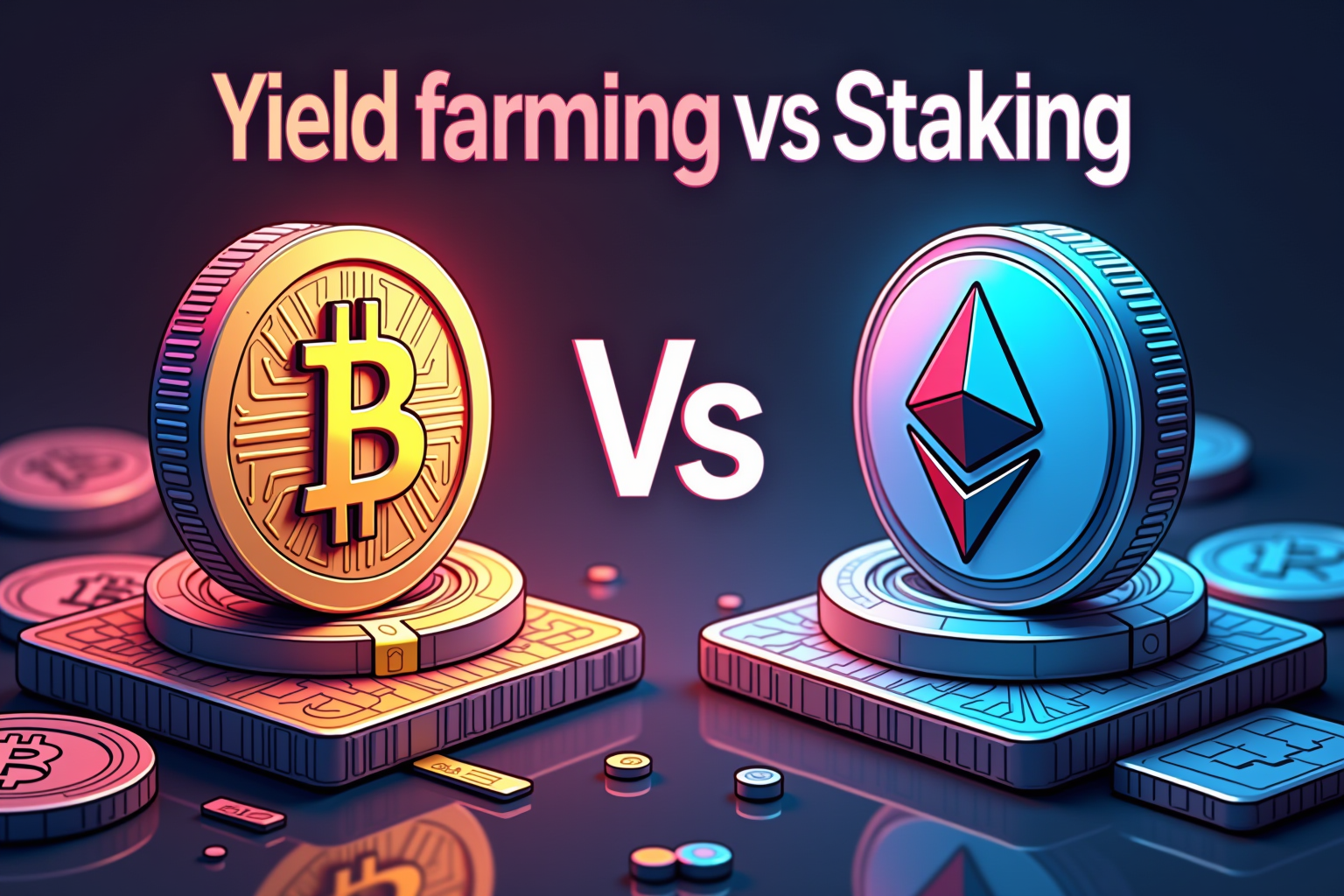Contents
- 1 Introduction to How to Stake Crypto for Beginning DeFi Raiders!
- 2 What is Crypto Staking?
- 3 Staking vs. Yield Farming: What’s the Difference?
- 4 How to Stake Crypto Step 1: Choosing the Right Cryptocurrency for Staking
- 5 How to Stake Crypto Step 2: Setting Up a Staking-Compatible Crypto Wallet
- 6 How to Stake Crypto Step 3: Selecting a Reliable Staking Platform
- 7 How to Stake Crypto: A Step-by-Step Run-Down
- 8 How Does Compounding Staking Rewards Work?
- 9 Risks of Staking Crypto
- 10 Final Thoughts on How to Stake Crypto
- 11 How to Stake Crypto and Start Earning Today!
- 12 How to Stake Crypto for Beginners FAQs
Views: 8
Introduction to How to Stake Crypto for Beginning DeFi Raiders!
Cryptocurrency has opened the door to a wide variety of ways to earn passive income, and one of the most popular methods is staking cryptocurrency. For those new to the world of crypto asking how to stake crypto, the task may seem like an intimidating or daunting concept at first glance, but it’s actually a straightforward and effective way to grow your digital assets without needing to actively trade or engage in complex and technical mining operations.
In this guide, we’ll break down everything you need to know about how to stake crypto, even if you’re a total noob to crypto, including what staking is, how it works, and how you can start earning staking rewards today. We’ll also walk you through the process of choosing the right cryptocurrencies, setting up a staking wallet, and selecting a reliable staking platform. By the end of this guide, you’ll be well-equipped to start staking and earning rewards in just a few simple steps.

What is Crypto Staking?
At its core, crypto staking is the process of participating in the validation of transactions on a blockchain network by locking up, or “staking,” a certain amount of cryptocurrency. This process is unique to Proof-of-Stake (PoS) blockchains and is one of the methods that these networks use to secure themselves and process transactions. In return for staking your coins, you earn staking rewards, typically in the form of additional cryptocurrency.

How Does Crypto Staking Work?
Crypto staking works by locking up your cryptocurrency to help a blockchain network validate transactions. It’s specific to Proof-of-Stake (PoS) blockchains. When you stake your crypto, you’re essentially helping to secure the network and, in return, you earn staking rewards. The more coins you stake, the better your chances of being chosen to validate transactions and collect rewards.
How to Start Staking Crypto:
- Choose a PoS cryptocurrency: Examples include Ethereum, Solana, Tron, KCS or Cardano.
- Set up a staking wallet: Use a secure wallet like MetaMask or Trust Wallet.
- Select a staking platform: Popular options include Binance, Coinbase, or staking pools .
Staking is like earning interest by supporting a blockchain’s operations. If you don’t run your own validator node, you use your funds to vote for one you have confidence in. However, beware of risks like market volatility or penalties (slashing) if validators misbehave.
How Does Staking Work?
Staking is often compared to earning interest on a savings account. When you stake your crypto, you’re essentially locking it away for a period of time to help maintain the network’s integrity. Here’s a simplified breakdown of how it works:
- Locking your crypto: You place a certain amount of cryptocurrency in a wallet or platform to participate in the network.
- Validating transactions: Your staked crypto helps validate transactions on the blockchain. The more you stake, thcoie greater your chance of being selected to validate and earn rewards.
- Earning rewards: In return for your participation, you’re rewarded with new coins. These rewards are calculated based on the amount you’ve staked and the specific rules of the blockchain.
Why Should You Stake Crypto?
There are several compelling reasons to stake crypto, especially if you’re looking for a way to grow your holdings without the need for constant trading or involvement in complex activities like mining.
- Passive Income: The most significant benefit of staking is that it provides a passive income stream. Instead of just holding your crypto in a wallet and waiting for its value to rise, you can earn staking rewards regularly.
- Network Support: By staking, you are directly contributing to the security and efficiency of the blockchain network. Staking makes networks more decentralized and secure by distributing the validation process across many participants.
- Lower Entry Barrier: Unlike crypto mining, which requires expensive hardware and consumes a significant amount of energy, staking is much more accessible. All you need is a staking wallet and a compatible cryptocurrency.
- Potential for Growth: While staking rewards can be substantial on their own, there’s also the potential for the underlying asset to appreciate in value over time, further increasing your gains.
Now that you understand the basics of staking and its benefits, let’s move on to the step-by-step process of how to stake crypto.
Staking vs. Yield Farming: What’s the Difference?
While both staking and yield farming are popular ways to earn passive income in the crypto world, they differ significantly in how they work and the level of risk involved.

Staking involves locking up your cryptocurrency to support a blockchain network’s operations (such as validating transactions) and earning rewards over time. It’s generally seen as a lower-risk strategy, with more predictable returns.
Yield farming, on the other hand, is part of the decentralized finance (DeFi) ecosystem. It typically involves lending or providing liquidity to decentralized platforms, such as decentralized exchanges (DEXs), to earn interest or additional tokens. Yield farming often offers higher returns than staking but comes with greater risks, such as impermanent loss or volatility in DeFi protocols.
For a more detailed breakdown of staking and yield farming, including their unique benefits and risks, check out this comprehensive guide comparing both strategies and helping you decide which suits your financial goals best.
How to Stake Crypto Step 1: Choosing the Right Cryptocurrency for Staking
Not all cryptocurrencies are designed for staking. To stake crypto, you’ll need to choose a coin that operates on a Proof-of-Stake (PoS) or a variant like Delegated Proof-of-Stake (DPoS) or Liquid Proof-of-Stake (LPoS). Here are some factors to consider when choosing a staking-compatible cryptocurrency:

Popular Cryptocurrencies for Staking
- Ethereum (ETH): Ethereum, one of the largest blockchain networks, transitioned from Proof-of-Work (PoW) to PoS with the launch of Ethereum 2.0. Ethereum staking offers attractiverewards, but it requires a minimum of 32 ETH for direct staking. For smaller amounts, staking pools are a great alternative.
- Cardano (ADA): Cardano Staking is known for its robust mechanisms, and it’s a popular choice among stakers due to its flexibility and relatively low minimum stake requirement.
- Solana (SOL): Solana staking is taking place on a growing network that offers impressive rewards. It’s designed to support high-speed transactions, and staking is a key part of its operation.
- Polkadot (DOT): Polkadot’s staking process is straightforward, and it offers solid staking rewards. Polkadot also allows nominators to delegate their tokens to validators, making it more accessible.
- Tezos (XTZ): Tezos has a self-amending blockchain, and it is often lauded for its user-friendly staking process, called “baking.”
Factors to Consider When Choosing a Cryptocurrency for Staking
- Annual Percentage Yield (APY): Each cryptocurrency offers different reward rates, often expressed as APY. Do your research to find the most lucrative options.
- Minimum Staking Requirements: Some blockchains have minimum staking requirements, like Ethereum’s 32 ETH for direct staking. Make sure you choose one that aligns with your budget.
- Lock-up Periods: Certain networks require you to lock up your crypto for a set period before you can unstake it. Shorter lock-up periods or flexible staking options may be better for beginners.
- Network Reliability: Always choose established and reliable blockchain networks with a good track record. Newer projects may offer higher rewards but carry more risk.
How to Stake Crypto Action Steps:
- Research and choose a cryptocurrency with a PoS consensus model.
- When asking How to Stake Crypto consider factors like APY, minimum staking amount, and lock-up periods.
- Purchase your chosen cryptocurrency from a reputable exchange like Binance, Coinbase, or Kraken.
How to Stake Crypto Step 2: Setting Up a Staking-Compatible Crypto Wallet
To stake crypto, you’ll need a wallet that is compatible with the cryptocurrency you intend to stake. A crypto wallet is essentially a secure digital vault where you can store, manage, and stake your assets.

Types of Crypto Wallets
There are several types of wallets you can use for staking:
- Software Wallets: These are applications that can be downloaded onto your computer or mobile device. Examples include MetaMask, Trust Wallet, and Exodus. These wallets are user-friendly and often support staking directly within the app.
- Hardware Wallets: Hardware wallets like Ledger and Trezor offer the highest level of security by keeping your private keys offline. While these are ideal for long-term storage, not all hardware wallets support staking natively, so check before purchasing.
- Exchange Wallets: Some exchanges, like Binance and Kraken, offer built-in staking features within their wallets. While this is convenient, it may not be as secure as using a dedicated wallet.
- Official Wallets: Many blockchains, like Cardano or Polkadot, offer their own official wallets, specifically designed to support staking on their network.
Setting Up Your Wallet
Setting up a crypto wallet is a straightforward process:
- Download the wallet: Visit the official website of the wallet you’ve chosen and download the software to your device. For hardware wallets, you’ll need to order the device and follow the setup instructions.
- Create your wallet: Upon opening the wallet application, you’ll be prompted to create a new wallet. Follow the instructions to set up your wallet, including generating a strong password.
- Backup your recovery phrase: During setup, the wallet will provide you with a recovery phrase, which is a series of words that act as a backup in case you lose access to your wallet. Write this down and store it securely offline.
- Transfer your crypto: Once your wallet is set up, transfer the cryptocurrency you want to stake from an exchange or another wallet into your staking-compatible wallet.
Action Steps:
- Choose a software, hardware, or exchange wallet that supports staking for your chosen cryptocurrency.
- Set up your wallet, ensuring you store your recovery phrase in a safe location.
- Transfer the cryptocurrency you want to stake into your wallet.
How to Stake Crypto Step 3: Selecting a Reliable Staking Platform
Now that you have your cryptocurrency and wallet ready, it’s time to choose a platform where you’ll stake your crypto. When asking how to Stake Crypto one of the key factors is choosing a reputable staking platform. A staking platform is essentially a service that connects stakers to the blockchain network and facilitates the staking process. There are two primary types of staking platforms: centralized exchanges and decentralized staking pools.

Centralized Staking Platforms (Exchanges)
Exchanges are a popular option for beginners because they simplify the staking process by handling all the technical details for you. Some of the most trusted centralized platforms for staking include:
- Binance: One of the largest exchanges in the world, Binance offers a variety of staking options, including locked staking and flexible staking.
- Coinbase: While not as extensive as Binance, Coinbase provides staking services for popular coins like Ethereum and Tezos, with a user-friendly interface for beginners.
- Kraken: Kraken allows staking for various coins, including Polkadot and Ethereum, and provides competitive reward rates.
Pros of Using Exchanges:
- Ease of Use: Exchanges handle the staking process, making it simple for newcomers.
- Security: Reputable exchanges have robust security measures in place.
- Liquidity: Some exchanges offer flexible staking, allowing you to withdraw your staked assets at any time without penalties.
Cons of Using Exchanges:
- Fees: Exchanges may charge a commission on staking rewards.
- Control: When staking through an exchange, you give up some control over your private keys and the staking process.
Decentralized Platforms for Staking Crypto
If you prefer a more decentralized approach, you can stake directly on the blockchain through a staking pool. Staking pools are groups of stakers who combine their resources to increase their chances of validating blocks and earning rewards. Examples of decentralized staking platforms include:
- Cardano Staking Pools: Cardano’s ecosystem allows users to delegate their ADA to various staking pools directly from their wallet.
- Polkadot Nominators: In the Polkadot network, you can nominate validators who stake on your behalf.
Pros of Using Staking Pools:
- Higher Control: You maintain control over your private keys and funds.
- Transparency: You can directly see and choose which validators or pools are securing the network.
Cons of Using Staking Pools:
- Technical Knowledge: Staking through decentralized platforms often requires more understanding of how the blockchain operates.
- Rewards Variability: Depending on the performance of your chosen staking pool or validator, rewards may vary.
How to Stake Crypto: Evaluating Staking Platforms
When selecting a staking platform, it’s crucial to evaluate the following:
- Reputation and Security: Ensure the platform has a good track record and security measures to protect your assets.
- Fees: Some platforms charge fees for staking, so compare options to maximize your rewards.
- APY (Annual Percentage Yield): Different platforms may offer varying reward rates for the same cryptocurrency. Research which one offers the best APY while maintaining reliability.
- Lock-Up Period: Some platforms require you to lock up your crypto for a certain period. Choose a platform with terms that suit your financial goals.
Action Steps for Staking Crypto:
- Research and select a staking platform or pool that fits your needs.
- Consider the platform’s reputation, fees, and staking rewards.
- If using a decentralized platform, choose a reliable validator or staking pool.
How to Stake Crypto: A Step-by-Step Run-Down

Now that you have your cryptocurrency, wallet, and staking platform ready, it’s time to actually stake your assets. The process may differ slightly depending on the platform and cryptocurrency you’ve chosen, but the basic steps remain the same.
Actionable Steps to Stake Crypto:
- Choose Your Cryptocurrency: Select a staking-compatible cryptocurrency like Ethereum, Cardano, or Solana.
- Get a Staking Wallet: Download a staking-compatible wallet (e.g., Trust Wallet, MetaMask, or Ledger) and secure it with a strong password.
- Fund Your Wallet: Buy or transfer the cryptocurrency you plan to stake into your staking wallet.
- Connect to a Staking Platform: Choose between a centralized exchange like Binance or a decentralized staking pool, and connect your wallet.
- Select a Staking Pool or Validator: If using a decentralized option, research and select a staking pool or validator that offers reliable performance and rewards.
- Initiate Staking: Follow the platform’s instructions to lock your assets for staking.
- Monitor Rewards: Keep an eye on your staking rewards, which will be paid out periodically based on the platform’s terms.
- Unstake When Ready: If needed, follow the platform’s unstaking process to withdraw your assets.
How to Stake Crypto: Calculating Rewards
Staking rewards can vary significantly depending on the cryptocurrency, platform, and market conditions. Most staking platforms provide an estimated APY (Annual Percentage Yield), which gives you an idea of how much you can earn over a year by staking. However, actual rewards may fluctuate based on several factors:
- Amount Staked: The more you stake, the higher your rewards.
- Network Activity: On some blockchains, rewards are influenced by how many transactions occur on the network.
- Validator Performance: If you’re staking through a pool, the performance of your chosen validator can impact your earnings.
Use online staking calculators, provided by exchanges or blockchain networks, to estimate your potential earnings before staking.
How Does Compounding Staking Rewards Work?
Compounding staking rewards involve reinvesting the rewards you earn from staking back into the staking pool. Instead of withdrawing your rewards, you add them to your staked amount, which increases the principal. Over time, this larger staked balance generates more rewards, allowing you to earn exponentially more than with a fixed staking amount. The longer you compound, the greater your potential returns due to the “snowball” effect of compounding.

How to Compound Staking Rewards:
- Select a platform: Ensure your staking platform supports automatic reward compounding.
- Reinvest manually or automatically: Some platforms auto-compound rewards, while others require manual reinvestment.
- Maximize returns: Compounding over time can significantly boost your annual percentage yield (APY).
Compounding rewards turns staking into a powerful wealth-building strategy, ideal for long-term holders looking to maximize their passive income.
Risks of Staking Crypto
While staking crypto offers numerous benefits, it’s essential to be aware of the risks involved:
- Price Volatility: The value of the cryptocurrency you stake can fluctuate, potentially affecting the value of your rewards and the initial staked amount.
- Lock-Up Periods: Some staking platforms require you to lock up your crypto for a fixed period. During this time, you may not be able to access or sell your assets, which can be a disadvantage in a volatile market.
- Slashing: On some blockchains, validators who misbehave or fail to meet performance standards can be penalized, resulting in a loss of staked funds (though this is rare).
- Platform Risk: If you’re staking through a centralized platform or exchange, you’re entrusting your funds to that service, which comes with inherent risk if the platform is hacked or experiences financial difficulties.
How to Minimize Risks When Staking Crypto:
- Diversify Your Staking: Instead of staking all your assets in one network or platform, consider diversifying across multiple blockchains or validators.
- Choose Reputable Platforms: Always stake with well-established and trusted exchanges or decentralized pools.
- Stay Informed: Keep up with the latest news and updates related to your chosen blockchain, as changes in the network could impact your staking rewards or security.
Final Thoughts on How to Stake Crypto
Staking is an excellent way for beginners and experienced investors alike to earn passive income while supporting the blockchain networks they believe in. With the proper research and a bit of planning, staking can become a highly rewarding strategy that complements other crypto investments.
If you’re ready to start staking, follow the steps outlined in this guide: select a staking-compatible cryptocurrency, set up a wallet, choose a reliable staking platform, and lock in your assets to start earning rewards. As you grow more comfortable with staking, you may want to explore advanced options like running your own validator or participating in DeFi protocols.
How to Stake Crypto and Start Earning Today!
Now that you understand how to stake crypto, it’s time to put your digital assets to work. Whether you’re looking to earn passive income, you want to support your favorite blockchain, or are looking to diversify your crypto portfolio, then staking is a fantastic strategy to consider. Take the first step by choosing a staking platform, and explore more of our crypto guides to continue building your knowledge and skills.
Happy staking DeFi Raiders!
How to Stake Crypto for Beginners FAQs
1. What is staking crypto?
Staking Crypto is the process of locking up your cryptocurrency to help validate transactions on a blockchain network (using Proof-of-Stake) in exchange for staking rewards. It’s a way to earn passive income without needing to mine or trade actively.
2. How do I start staking crypto?
To start staking, you need to choose a staking-compatible cryptocurrency, set up a wallet, transfer funds, and then connect to a staking platform or pool. You can stake through exchanges like Binance or Coinbase or directly on the blockchain via staking pools.
3. Which cryptocurrencies can I stake?
Only cryptocurrencies that use Proof-of-Stake (PoS) or similar consensus mechanisms can be staked. Popular staking coins include Ethereum 2.0 (ETH), Cardano (ADA), Solana (SOL), Polkadot (DOT), and Tezos (XTZ) and many more.
4. What kind of wallet do I need for staking?
You need a wallet that supports staking for the cryptocurrency you’re staking. Popular options include software wallets like MetaMask or Trust Wallet, hardware wallets like Ledger, and exchange wallets.
5. How are rewards for staking crypto calculated?
Staking rewards are typically calculated based on factors like the amount you stake, the network’s total staking participation, and the APY offered by the platform or blockchain often times calculated based on network fees or fees generated by said platform. Rewards are paid out periodically. The period varies based on the blockchain or platform you use to Stake.
6. Can I lose money if I stake crypto?
Yes, there are risks. The value of your staked crypto can fluctuate due to market volatility, and some platforms require you to lock up your assets for a set period. In rare cases, bad validators can be penalized, affecting your rewards. Furthermore there is often a lock period of anywhere from a few days to a month on Proof-of-Stake assets. If there is a down-turn coming in price, and your assets are locked, you might miss the chance to sell off before a crash even if you know it is coming.
7. What’s the difference between centralized and decentralized staking?
Centralized staking is done through exchanges like Coinbase, Binance, or Kraken, which handle the staking process for you. Decentralized staking is done directly on the blockchain through staking pools, offering more control but requiring more technical knowledge.
8. Are there any fees for staking crypto? Some staking platforms or exchanges may charge a small commission on your staking rewards. Always check the fee structure before staking, as lower fees can maximize your earnings.
9. How long do I need to stake my crypto? The lock-up period varies depending on the cryptocurrency and the staking platform. Some platforms offer flexible staking with no lock-up, while others require a fixed duration, such as 30 days or more.
10. Can I use small amounts to stake crypto? Yes! Some cryptocurrencies and platforms allow staking with small amounts. However, certain networks like Ethereum 2.0 require a minimum amount (e.g., 32 ETH), but you can join staking pools to get started with less.

